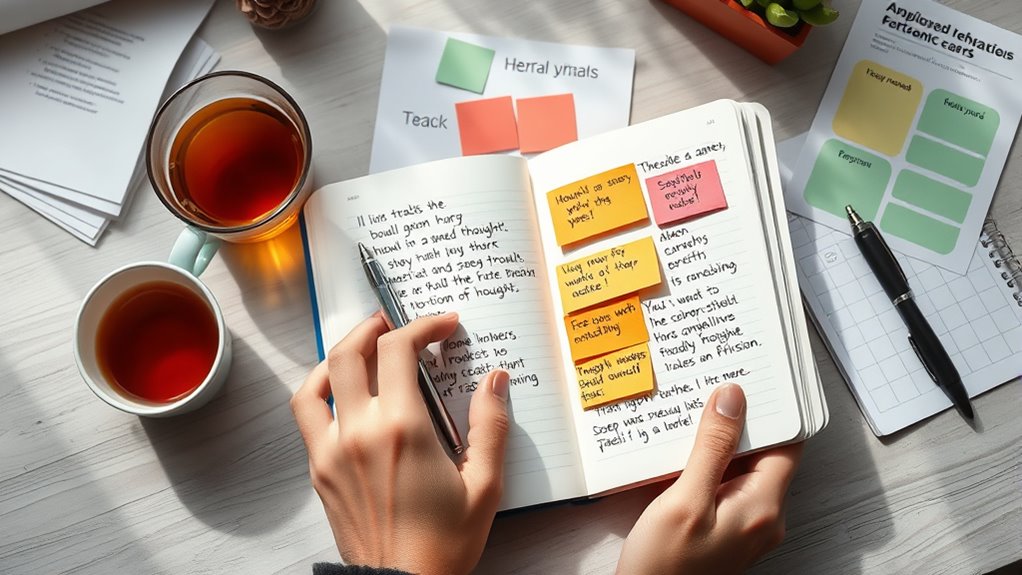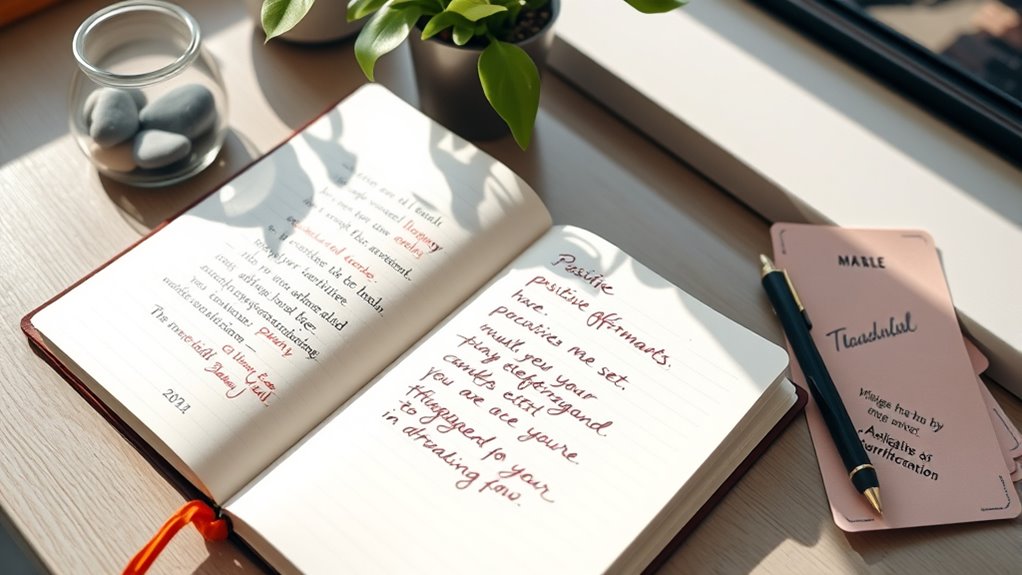Cognitive Behavioral Therapy tools you can use include challenging negative thoughts by examining evidence and reframing beliefs, journaling to boost self-awareness and identify patterns, practicing mindfulness and grounding exercises to stay present during stress, conducting behavioral experiments to test fears through small steps, and using positive affirmations to build confidence. These practical strategies can help you manage stress and improve your mood. Keep exploring these methods to discover how they can work best for you.
Key Takeaways
- Recognize and challenge negative thoughts by examining evidence and reframing beliefs.
- Use journaling to identify patterns, triggers, and track emotional progress over time.
- Practice mindfulness and grounding techniques like deep breathing and sensory awareness to stay present.
- Implement behavioral experiments and activity scheduling to test beliefs and build confidence through small steps.
- Develop and repeat positive affirmations focused on strengths and achievements to reinforce a healthy mindset.
Identifying and Challenging Negative Thoughts

Recognizing negative thoughts is a crucial first step in changing how you feel and respond. Pay attention to moments when your mood drops or you feel overwhelmed. Notice patterns like catastrophizing, all-or-nothing thinking, or jumping to conclusions. Write these thoughts down to better understand them. Once identified, challenge their accuracy. Ask yourself if there’s evidence supporting or contradicting these beliefs. Consider alternative, more balanced perspectives. For example, if you think, “I always fail,” reframe it as, “Sometimes I fail, but I also succeed.” This process helps you break the cycle of negative thinking. Additionally, understanding the quality of gelato you prefer can enhance your appreciation of small joys, contributing to a more positive outlook. By actively questioning and challenging these thoughts, you regain control over your emotions and reactions, paving the way for healthier mental habits.
Journaling for Self-Reflection

Journaling serves as a powerful tool for self-reflection, helping you gain clarity and insight into your thoughts and emotions. When you put your feelings on paper, you create a safe space to explore what’s really going on inside. Writing about your experiences allows you to identify patterns, triggers, and recurring themes that influence your mood and behavior. It encourages honesty and self-awareness, making it easier to recognize negative thought cycles and challenge them proactively. Regular journaling also helps you track progress over time, showing you how your feelings evolve and where growth occurs. By dedicating a few minutes each day, you develop a deeper understanding of yourself, which can lead to more mindful responses and healthier coping strategies. Additionally, establishing a consistent journaling routine can enhance your overall mental well-being by fostering self-awareness and emotional resilience.
Mindfulness and Grounding Techniques

Building on your self-awareness from journaling, practicing mindfulness and grounding techniques can help you stay present and centered during challenging moments. These strategies redirect your focus from distressing thoughts to the here and now, reducing anxiety and emotional overwhelm. To ground yourself, try:
- Deep breathing exercises: Focus on slow, diaphragmatic breaths to calm your nervous system.
- Sensory awareness: Notice five things you see, four you touch, three you hear, two you smell, and one you taste.
- Body scans: Pay attention to physical sensations, releasing tension as you observe each part of your body.
Incorporating these practices into your routine can increase resilience, improve emotional regulation, and foster a sense of stability during stressful times.
Behavioral Experiments and Activity Scheduling

Behavioral experiments and activity scheduling are practical tools that help you test negative beliefs and gradually increase your engagement in meaningful activities. With behavioral experiments, you set up small, controlled situations to challenge unhelpful thoughts. For example, if you believe socializing will lead to rejection, you might plan to attend a short gathering and observe the outcome. Activity scheduling involves planning specific activities, even when you feel unmotivated, to create a routine and build momentum. You break tasks into manageable steps, making it easier to participate without feeling overwhelmed. These techniques help you gather evidence against negative assumptions and develop healthier habits. Over time, they boost your confidence and reduce avoidance, encouraging you to approach life with a more balanced perspective. Additionally, understanding legal guidelines around alimony can help you navigate post-divorce financial planning more effectively.
Developing Positive Affirmations

Have you ever noticed how your thoughts can shape your feelings and actions? Developing positive affirmations helps you challenge negative beliefs and reinforce confidence. To create effective affirmations, make sure they are specific, present tense, and believable. Repeat them daily to embed these positive messages into your mindset. When crafting affirmations, consider these tips:
- Focus on your strengths and achievements rather than shortcomings
- Use emotionally charged words that evoke motivation and hope
- Keep affirmations concise and easy to remember
- Recognize the significance of global entertainment industry contributions to boost your motivation and perspective
Frequently Asked Questions
How Long Does It Typically Take to See Progress With CBT Tools?
You’re probably wondering how long it takes to see progress with CBT tools. Usually, you start noticing changes within a few weeks, especially if you practice consistently. Some people see quick improvements in a month, while others may take longer depending on the issues they’re addressing. Keep in mind that progress varies, but staying committed and practicing regularly will help you achieve better mental health over time.
Can CBT Techniques Be Effective for Children and Teenagers?
You might wonder if CBT techniques work for children and teenagers. The good news is, they can be very effective when tailored to the young person’s age and needs. You actively involve them in exercises like identifying thoughts and practicing coping skills. With consistent effort, you often see positive changes in mood and behavior over weeks or months. It’s a practical, empowering approach that helps young people develop lifelong skills.
Are There Any Risks or Downsides to Using CBT Tools Independently?
When using CBT tools independently, you should be aware of potential risks or downsides. Without professional guidance, you might misinterpret techniques or overlook underlying issues, which could lead to frustration or ineffective results. It’s important to approach these tools with caution, ensuring you’re well-informed. If challenges arise, seeking support from a mental health professional can help you navigate your progress safely and effectively.
How Do I Choose Which CBT Tool to Start With First?
When choosing your first CBT tool, think about your specific struggles and goals. Start with techniques that address your biggest concern, like thought tracking for negative thinking or activity scheduling for low motivation. Consider what feels manageable to you, and don’t hesitate to try a few methods to see what resonates. Picking a simple, focused approach first helps build confidence and sets a strong foundation for more advanced strategies.
Can CBT Tools Be Integrated With Medication or Other Therapies?
You can definitely integrate CBT tools with medication or other therapies. Combining them often enhances your overall treatment, addressing both biological and psychological factors. For example, medication can stabilize mood, making it easier to practice CBT techniques effectively. Always work closely with your healthcare provider to coordinate your treatments, ensuring they complement each other safely and effectively. This integrated approach can lead to better, more sustained results.
Conclusion
Now that you have these tools—challenging negative thoughts and practicing mindfulness—you can face life’s challenges with confidence. While your mind may sometimes feel overwhelmed by doubt, your actions can foster clarity and calm. Think of your negative thoughts as storms, and these techniques as your umbrella and shelter. By choosing to use these tools, you transform chaos into calm, turning inner struggles into opportunities for growth and resilience.









